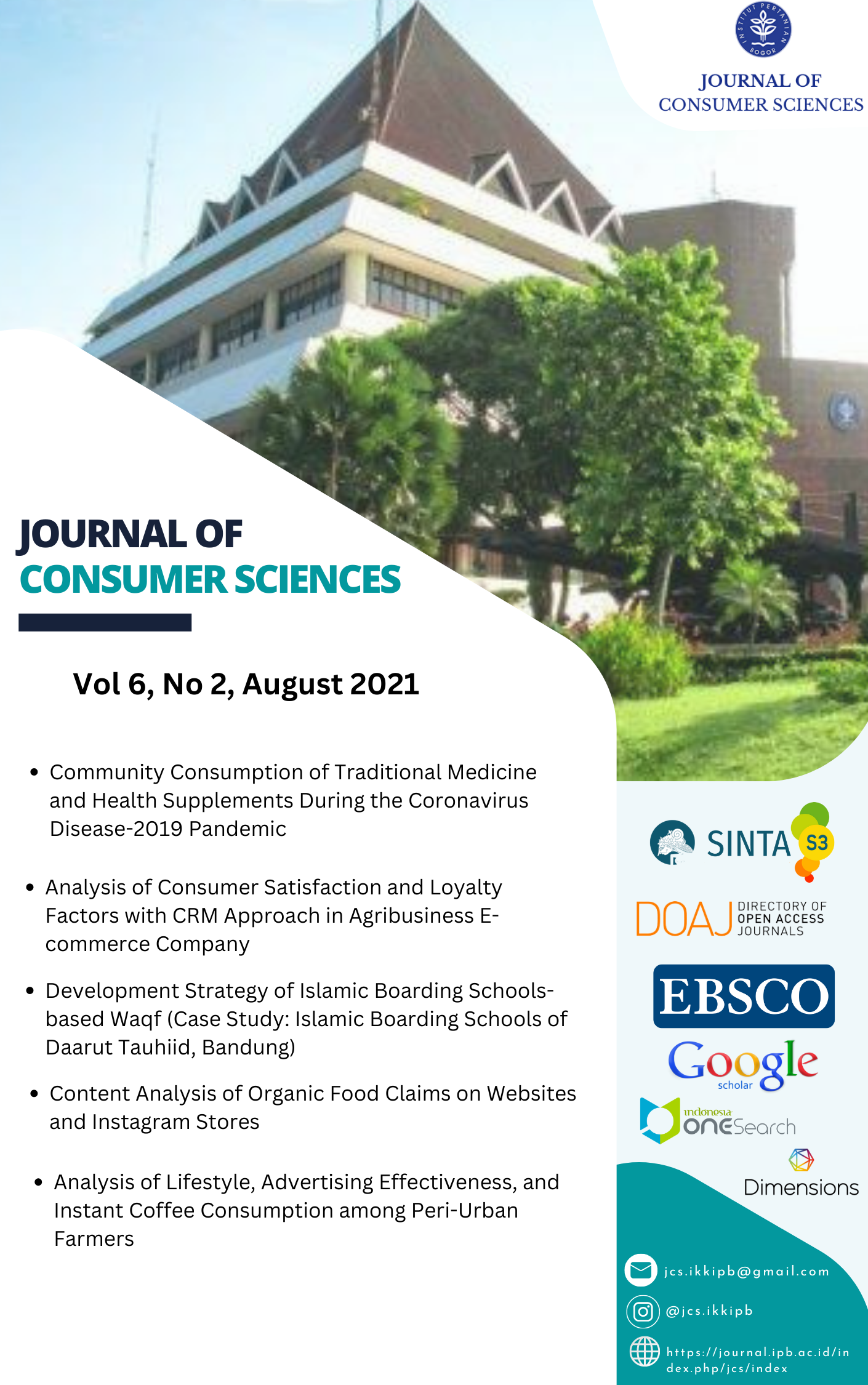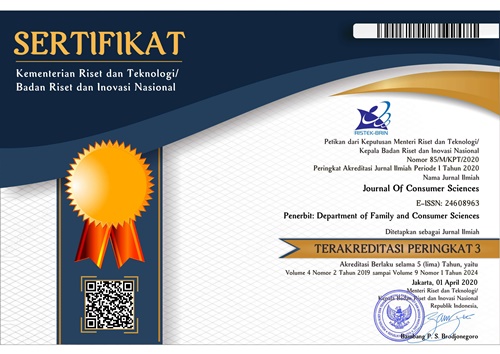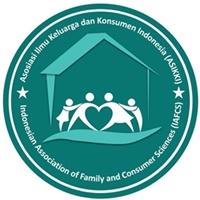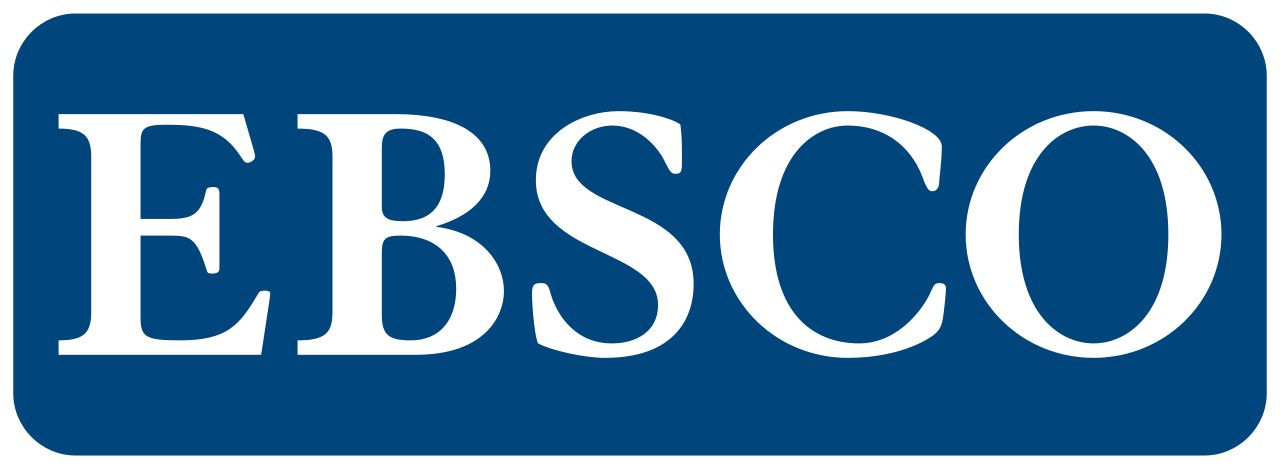Analysis of Lifestyle, Advertising Effectiveness, and Instant Coffee Consumption among Peri-Urban Farmers
Analysis of Lifestyle, Advertising Effectiveness, and Instant Coffee Consumption among Peri-Urban Farmers
Abstract
Coffee consumption is increasing because many types of coffee are circulating, such as instant coffee among the public. The instant coffee studied in this study is the Iwan Fals edition of instant coffee. This study aimed to analyse the lifestyle and effectiveness of instant coffee advertising on instant coffee consumption among peri-urban farmers in Bogor Regency. This study used a cross-sectional study design located in Cibungbulang District, Bogor Regency. The location was chosen purposive because it is a peri-urban area that has more than 20% of agricultural land. A total of 100 respondents in this study were selected using a purposive sampling method with the criteria of a farmer and in the last 12 months consuming and viewing Iwan Fals edition coffee advertisements. The results of this study found that the maker's lifestyle is the most (32%) owned by the respondents. The effectiveness of instant coffee advertising in this study is included in the effective category (3.54). The results showed a relationship between gender, believing lifestyle, trying hard lifestyle with instant coffee consumption. The influence test results found an influence of male gender and lifestyle beliefs on instant coffee consumption. In general, respondents are classified as effective in consuming coffee because of their lifestyle and increase energy.
References
[AEKI] Asosiasi Exportir dan Industri Kopi Indonesia. (2013). Indonesia coffee market. Retrieved from: http://www.aeki-aice.org.
AC Nielsen. (2008). EPIC model publication. Retrieved from: www.nielsen.com
Andriamsari, H. (2015). Potential and strategies for developing peri-urban agriculture in Bogor Regency. [Theses]. Bogor(ID): Institut Pertanian Bogor
[BPS] Badan Pusat Statistik. (2013). Number of Agricultural Workers. Jakarta(ID): Badan Pusat Statistik.
[BPS] Badan Pusat Statistik. (2017). National Economic Driver. Jakarta(ID): Badan Pusat Statistik
Bistara, D. N., & Kartini, Y. (2018). The relationship between coffee consumption habits and blood pressure in young adults. Journal of Vocational Health, 3(1), 23-28. E-ISSN: 2599-3275.
Budiarti E., Kurniawan A., Achsani A., Purnama D., & Rosyid F. (2013). The effectiveness of the good day advertising version Is this what it feels like to love television using the EPIC model. Journal of Cakrawala, 8(1), 70-77. Doi: https://doi.org/10.32781/cakrawala.v8i1.223
Durianto, D., Sugiarto, A.W., & Supratigno, H. (2003). Market Invasion With Effective Advertising Strategies, Programs, and Measurement Techniques. Jakarta(ID): Gramedia Pustaka Utama.
Fatimah, S. (2013). The influence of lifestyle and self-concept on consumer decision making in choosing a coffeeshop in Samarinda. Journal of Management, 1(1), 1-8.
Hadi, M. P., Wahono, B. (2015). Analysis of the effectiveness of "Top Coffee" advertising with the EPIC Model approach. Management Scientific E-Journal, 4(3), 427-440
Handoko, S. R. (2006). Analysis of the influence of endorser credibility and advertising creativity on the effectiveness of advertising that affects attitudes towards the brand. [Theses]. Semarang(ID): Universitas Dipenegoro.
Hyun, J. L., Hyeon, J. C., Wenwen, X., & Ann Fairhurst. (2010). The Influence of Consumer Traits and Demographics on Intention to Use Self-service Checkouts. Journal of Marketing Intelligence and Planning, 28(1), 46-58. Doi: http://dx.doi.org/10.1108/02634501011014606
Jung, W. L. (2010). The roles of demographics on the perceptions of electronic commerce adoption. Academy of Marketing Studies Journal, 14(1): 71-89.
[Kemenperin] Kementerian Perindustrian Republik Indonesia. (2013). Coffee processing industry roadmap. Retrieved from agro.kemenperin.go.id.
[Kemenperin] Kementerian Perindustrian Republik Indonesia. (2016). Coffee processing industry roadmap. Retrieved from: agro.kemenperin.go.id.
[Kementan] Kemenetrian Pertanian. (2017). Statistik Perkebunan Indonesia: Kopi. Jakarta(ID): Kementerian Pertanian Republik Indonesia.
Kotler, P., & Keller, K. N. (2008). Marketing Management. Jakarta(ID): Erlangga. Translated by bob sabran MM.
Lee, M., & Jhonson, C. (2007). Fundamental Principles of Advertising in a Global Perspective. Jakarta(ID): Kencana.
Meliala, R. R. (2017). Coffee consumption rates by income, age, and price in Depok. [Theses]. Jakarta(ID): UIN.
Mifzar, F., & Sinaga, A. (2015). Analysis of the factors that influence consumer behavior in making instant coffee purchasing decisions. SEPA Journal (Socio-Economic Agriculture and Agribusiness), 11(2), 175-180. Doi: https://doi.org/10.20961/sepa.v11i2.14172
Mowen & Minor. (2012). Consumer Behavior Volume I 5th Edition. Jakarta(ID): Erlangga
Patterson & Paul, G. (2007). Demographic correlates of loyalty in a service context. Journal of Service Marketing, 21(2),112-121. Doi: http://dx.doi.org/10.1108/08876040710737877
Putrie, N. K. (2016). Differences in motivation to buy fashion products online for men and women at Satya Wacana Christian University. [Theses]. Salatiga(ID): Universitas Kristen Satya Wacana Salatiga
Rahmawati, N. (2013). The effect of using celebrity endorsers in Lux soap advertisements on consumer behavior in Sungai Dama Samarinda Village. Journal of Communication Studies, 1(1), 362-373.
Satyajaya, W., Rangga, A., Nurainy, F., & Al Rasyid, H. (2014). Consumer decision making process and product attributes of instant coffee. Jurnal Teknologi & Industri Hasil Pertanian, 19(3), 297-306. Doi: http://dx.doi.org/10.23960/jtihp.v19i3.297%20-%20306
Setiadi, N. J. (2008). Consumer Behavior: Concepts and implications for marketing strategy and research. Jakarta(ID): Kencana
Setyawan, I. (2014). Analysis of the effectiveness of instant coffee television advertisements TOP COFFEE endorser "Iwan Fals". Business management, 4(1), 39-49. Doi: https://doi.org/10.22219/jmb.v4i1.5279
Simanjuntak, D. F. (2013). Consumer attitudes against top coffee instant powder in Bogor City Area, West Java. [Theses]. Bogor(ID): Institut Pertanian Bogor.
Solikatun, S., Kartono, D. T, & Demartoto, A. (2015). Coffee Consumption Behavior as a Consumption Community Culture (Phenomenological Study on Coffee Drinkers at Coffee Shops in Semarang City). Journal of Sociological Analysis, 4(1), 60-74. Doi: https://doi.org/10.20961/jas.v4i1.17410
Sumarwan, U. (2011). Consumer Behavior: Theory and Its Application in Marketing 2nd Edition. Jakarta(ID): PT Ghalia Indonesia.
Swastika, K. D. (2012). The effect of coffee on post prandial blood sugar levels in seventh semester students of the USU Faculty of Medicine in 2012. [Theses]. Medan(ID): Univesitas Sumatera Utara.
[SWA] SWA majalah digital. (2010). Tren kopi. 1-3.
Tjiptono, F., Chandra, G., & Adriana, D. (2008). Strategic Marketing. Yogyakarta(ID): Andi.
Umar, H. (2003). Strategic Marketing Service Consumer Behavior Research Methods. Jakarta(ID): Ghalia Indonesia
Upphaswara, A. M. (2014). Analysis of competition map of sachet instant coffee products in Bogor City. [Theses]. Bogor(ID): Institut Pertanian Bogor.
Wadi, H., & Rahanatha, G. B. (2013). The relationship between demographic variables and consumer responses to advertisements for top coffee brand coffee products in Denpasar City. Udayana University Management E-Journal, 2(9), 1036-1052. E-ISSN: 2302-8912.
Willbanks, J. K. (2005). Exploring lifestyle orientation. Attitude toward lifestyle merchandising, and attitude toward lifestyle advertising as presdictor of behavioral intention to purchase lifestyle home furnishing product. [Theses]. Texas(US): Uniedisity of North Texas.
Yulisa, L., Indriani, Y., & Situmorang, S. (2013). The consumption behavior of Lampung University students towards instant ready-to-eat ground coffee. Journal of Agribusiness Sciences, 1(4), 326-333. Doi: http://dx.doi.org/10.23960/jiia.v1i4.326-333.
Yunianto A. E. (2015). Knowledge, lifestyle, and nutritional status and their relation to blood glucose status in rural men and women. [Theses]. Bogor(ID): Institut Pertanian Bogor.
Authors who publish with this journal agree to the following terms:
- Authors retain copyright and grant the journal right of first publication with the work simultaneously licensed under a

This work is licensed under a Creative Commons Attribution 4.0 International License. that allows others to share the work with an acknowledgement of the work's authorship and initial publication in this journal. - Authors are able to enter into separate, additional contractual arrangements for the non-exclusive distribution of the journal's published version of the work (e.g., post it to an institutional repository or publish it in a book), with an acknowledgement of its initial publication in this journal.
- Authors are permitted and encouraged to post their work online (e.g., in institutional repositories or on their website) prior to and during the submission process, as it can lead to productive exchanges, as well as earlier and greater citation of published work (See The Effect of Open Access).











